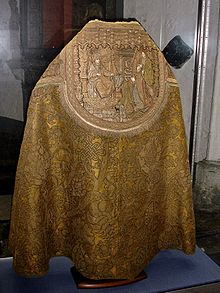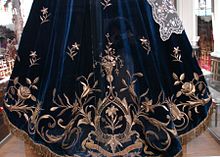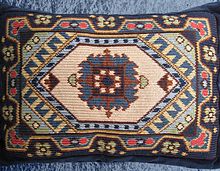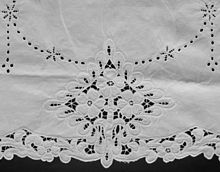Embroider
Embroidery is a textile technique in which a carrier material ( fabric , leather , paper ) is decorated by pulling threads through or sewing on . There are a variety of embroidery techniques.
Quill embroidery is a special form .

History of embroidery
Maintained by the Chinese from ancient times, embroidery was also known to the ancient Indians and Egyptians . These did not go beyond geometric figures in their decorative drawings , whereas the Assyrians first depicted animal and human figures on their smoothly adjoining clothes and curtains. The Greeks learned from them and from them the Romans , who called embroidery Phrygian work . In the Middle Ages it was in the monasteries in the service of worship for religious vestments and altar clothes ( vestments maintained).
Her work was surpassed by Arab art institutions from the 11th century . Rare examples, such as a German imperial coronation cloak, still testify to the height of the art of embroidery at that time. With spiritual education, the art of embroidery also came into secular hands. First in England , but later in Burgundy , it reached the highest level of education in the 14th century and has since then slowly fallen into complete disrepair, where it too received its share in the general improvement of the arts and crafts and now, in part, an understanding care through larger studios (Bessert-Nettelbeck in Berlin).
The embroidery not only decorates, but it often completely covers the underlying fabric; one could differentiate between white and colored embroidery, although with the latter the reason is sometimes left open.
Colored embroidery

Stained embroidery can be either a dense ground on canvas, cloth, silk, leather, or a specially made to, sieve-like perforated fabric, canvas , from hemp , linen , cotton , and silk be placed. The common cross stitch and its varieties (tapestry stitch, weaving stitch) as well as the very fine petitpoint stitch , which enables very delicate, mosaic-like sculptures, are mainly executed on canvas . Less laborious than the latter, but better suited than the cross stitch for figurative representation, is the satin stitch , with which the medieval works are almost entirely made on dense ground. While the petitpoint stitch is only made with silk thread, dyed wool is usually used for the other types of stitches, even if silk, gold thread and even pearls are sometimes sewn into them. Other types of embroidery are: the chain stitch, in which each stitch is made twice, the thread going from bottom to top and back through the same hole, thus forming a loop through which it comes up again after passing through a new hole , is pulled; the lock stitch , in which a long stitch is made on the lower side of the fabric, is returned to the upper side by half the extent of the same, so that on the lower side each stitch is twice as long as above; the reverse is used to create the stem stitch. Still other types of stitching (lichen stitch, double stitch, lattice stitch, Moorish, Spanish stitch) are described in Lipperheide, Muster old Italian linen embroidery (Berl. 1881–85, 2 vols.).
The type of gold embroidery, famous in the Middle Ages, which produced such a wonderful effect as you can still see in the so-called Burgundian robes ( chasubles ) from the 15th century in Vienna , is technically very different from ours. While the gold threads are now treated like other threads, they used to be laid parallel to each other and sewn with overlay stitches. The actual embroidery, through which the gold shimmered (relief embroidery), was then placed on the ground that had just been formed. Today's gold and silver canister embroidery is already approaching pearl embroidery . This row by row of cheap glass beads has contributed a lot to the decline of art because it makes the raw material heavy and inflexible. For the artistic value, the preliminary drawing of the pattern is always important, which is now rarely the invention of the maker of an embroidery. The production of patterns, on the other hand, has become a special branch of industry for design engineers or pattern makers .
Another type of embroidery is tambouring, which is not done with a sewing needle but with a crochet hook, like on the back of the hand of fine ice cream gloves. Furthermore, fine leather goods, especially in America, are now very delicately decorated with lockstitch made on the sewing machine.
Whitework
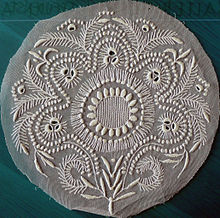
The whitework, apart from the name embroidery, the drawing of the linen, is limited to the decoration of the linen and tableware in canvas or cotton (therefore also called linen embroidery). In the so-called French or Huguenot whiteworks, the satin stitch predominates, in the English the binding-hole stitch, which provides openwork work; however, both still use the languette stitch and various fantasy stitches. The Venetian whitework, in which the ground is removed in places after work, so that the openwork areas are filled with fine thread entanglements, already touches the lace sewing. Whitework in Western Europe is more a matter of industry; In Germany, it is operated in the Saxon Vogtland , namely in Plauen (forerunner of the Plauener Spitze ), and the neighboring areas of the Ore Mountains and Upper Franconia in Bavaria, in the most extensive way with embroidery machines (see there). The traditional form of this elaborate handicraft is still practiced in Germany today in the area of the Schwalm in northern Hesse . The center of German machine embroidery has been the town of Plauen and the surrounding area since 1890, which became famous for the Plauen lace.
Hair embroidery
In hair embroidery, human hair is used instead of thread, which, due to its thin, shiny smoothness, enables particularly fine embroidery similar to silk embroidery.
This type of embroidery is still practiced in China, where it was created over 1300 years ago in Jiangsu Province.
Embroidery with human hair in the 19th century was also reported from Mexico, as well as from France and Germany.
techniques
Cross stitch
In this technique, small crosses are embroidered on a countable fabric. First a diagonal stitch is made, then a second one at an angle of 90 degrees. If you sew several crosses in a row, you first sew all the lower stitches next to each other and then the upper stitches in a back row above.
For this technique it makes sense to use a fabric that is coarsely woven and has countable threads.
Gold embroidery
Gold embroidery is the most precious form of embroidery alongside pearl embroidery. Ornaments are applied to a textile carrier with gold threads. It is mainly used for the manufacture of trimmings and is used for paraments of liturgical vestments.
Bargello
Also Florentine embroidery, an embroidery that covers the entire surface, in which the stitches are run parallel to the course of the thread over two to five cross threads. By slightly offsetting the stitches, abstract zigzag or curve patterns are created. The oldest demonstrable use on chairs of the 17th century in the possession of the Museo nazionale del Bargello , after which the technology is also named.
Kilim
The kilim stitch and its modification, the stem stitch, create patterns that look like they have been knitted. The kilim stitch pattern has horizontal ribs; those from the stalk stitch are vertical. Both patterns are made up of rows of diagonal stitches, with the stitches running in opposite directions in every other row. With the stem stitch, back stitches are worked between the rows of kilim stitches. Both stitches are suitable for large and small pattern areas.
gobelin
Tapestry embroidery is an imitation of picture knitting , named after the tapestry manufactory . In contrast to the knitting technique, which creates colored areas by inserting different colored weft threads into the tensioned warp threads, with tapestry embroidery the crosshairs of the carrier material are embroidered diagonally with colored embroidery thread. The character of the picture is determined by the skillful stitch-by-stitch composition with a few color tones. For murals, cushions and other decorative handicrafts, special canvas fabric is usually embroidered with tapestry embroidery thread made from pure new wool. Specialized kits are available from specialist retailers that contain both the canvas, on which the image can already be printed, and the mouline. Tapestry stitch: The very simple embroidery technique, also known as half cross stitch, is used to completely embroider the motif field on the carrier material, with diagonal crosshairs always running in the same direction. The quality of the finished handicraft is evident in the uniformity of the stitches, which completely cover the carrier material.
Needle painting
One speaks of needle painting when color transitions are created in the representations that are reminiscent of painted pictures. In needle painting, satin stitches are interlocking and nuanced in fine shades of color. The stitches are set tightly, the direction of the stitches follows the shape of the pattern. Needle painting is often combined with stem stitches, split stitches and knot stitches.
Untwisted, little twisted silk is particularly suitable as embroidery material. You can also use wool, chenille or spun.
Ajour embroidery
Ajour embroidery is an embroidery in which loosely woven fabric threads are pulled together with a thread, thereby creating openings. The edges do not have to be serged, as the openings can only be reached by pulling the threads together. Different types of perforations can be achieved with different stitch variations, which can then be filled with further lace stitches. Famous examples of this embroidery were the Dresden lace and the Ayrshire embroidery from Scotland.
Classic embroidery was only embroidered in white.
Richelieu
A form of whitework that is still popular today is so-called Richelieu or cutout embroidery. The edge line or the edge of the hole is then thickly embroidered with a festoon stitch (also called languette or loop stitch). You can then carefully cut away the fabric under the edge of the festoon stitch on the outer edge or in the hole. This embroidery was named after Cardinal Richelieu , who introduced it as a cheaper replacement for the elaborate needlepoint.
Hardanger
Hardanger embroidery technique is a special breakthrough embroidery technique .
Sashiko
Japanese decorating technique
Quill work
Quill work is an ornament technique used by Indians.
Mallorcan embroidery
Here, chain stitches are sometimes crocheted on the embroidery base with the crochet hook. If you crochet two rows with a little space between them, an area can be embroidered between the two rows by using the chain stitch threads to fix.
Another feature of this embroidery shape is that no threads are pulled even when the motifs are close together, so you can even embroider a lampshade.
Tools
yarn
For embroidery to use special yarns . The most common today are embroidery twist and pearl thread . Sticktwist is 6 ply and can also be divided into thinner strands for fine embroidery. Pearl yarn is indivisible, but it is shiny and has a smoother surface. But other materials can also be embroidered and were also embroidered in past centuries, for example silk filament, twisted silk thread, narrow silk ribbons, wool thread, cotton (sewing) thread or fancy threads such as chenille .
Embroidery needles
Needles are the most important and elementary work tool for sewing and embroidery. A sewing or embroidery needle is generally a specially shaped metal pin with an eye or an incorporated hook that can be used to pierce flat structures. The needles have one or two points. The sewing or embroidery thread, also known as needle thread, is pulled / threaded through the eye. With the hook of the hook needle (needle for crank and chain stitch machines) a thread loop can be picked up after piercing the sewing material or the embroidery base, thus creating a stitch.
There are five basic types of needles:
- Single-point sewing or embroidery needles for manual work with the eye in the shaft of the needle,
- two-point needles for hand embroidery machines with the eye in the middle of the needle,
- pointed needles for sewing and embroidery machines ,
- Hook needles for chain stitch or crank embroidery machines,
- Needles for special embroidery machines e.g. B., for oriental embroidery machines , tufting machines etc.
Hand sewing needle
Needles for hand sewing and embroidery are elongated, thin, straight or curved metal pins that terminate in a point at one end and have an eye at the other end. They exist
- with round tip for countable fabrics (Aida, Stramin etc.) and
- with a pointed tip for finer-threaded fabrics.
There are also different sizes. The finer the thread, the thinner the needle used should be. The needle diameter, the length of the needle and the eye (size and shape) are designed differently for use as a sewing or embroidery needle and for the thread to be processed. Embroidery needles are usually shorter and have a longer and larger eye.
The single-point sewing and embroidery needle has been the most important tool for sewing and embroidery for centuries.
Machine needle
Sewing and embroidery machine needles are pointed needles, i. H. the eye is in the area of the needle tip. Since sewing or embroidery threads slide through the eye of the machine needles with every stitch, the eyes have a special shape. They must be designed in such a way that the needle threads to be processed are not damaged and that thread breaks are avoided with a high number of stitches per unit of time.
The needles for embroidery machines are now available in a variety of special designs with regard to the shape and design of the eye, point, surface, material, etc. Thread hooks, also called thread hooks, are used to thread the needle thread into the eye while the shuttle embroidery machine is running - thread threading - and also when the machine is at a standstill.
Embroidery base
Depending on the technique used, there are different fabrics that are suitable for embroidery. The fabric should be countable for cross stitching, but not necessary for needle painting. Countable fabrics include Aida fabric, canvas or linen. Stretch fabrics, on the other hand, are unsuitable for any type of embroidery. For petit point embroidery, silk gauze is often used.
Embroidery hoop
To prevent the fabric from being pulled together by the embroidery and to avoid distortions in the pattern, the fabric is stretched tightly in an embroidery frame . This is usually round and consists of an inner and an outer ring, between which the fabric is placed.
Heavy substances or substances that are e.g. B. get a gold embroidery, need a square frame, which consists of a spar and two perforated slats. The fabric must be sewn onto the stiles as a rectangle, possibly rolled up onto the stiles and then stretched with the perforated slats that are passed through the stiles. In this way, even large-format embroidery can be realized very well without distortion.
Visual aids
For fine embroidery in particular, it is helpful to use a magnifying glass attached to a swivel arm. Such magnifiers are also available with an integrated lamp. Magnifying glasses should be large enough and close to the embroidery site to enable two-eyed viewing through the magnifying glass.
Even reading glasses offer the advantage of a closer range of focus of the eye.
Particularly bright, non-dazzling lighting can be created using a lamp with a small shade, which is moved up to 10 or 20 centimeters to the embroidery material.
Bright light allows the eye to darken the pupil, which creates a high depth of field and eliminates the edge defects of the lens.
Embroidery pattern
Embroidery designs are mostly printed on paper or fabric. Paper templates are available as color templates or symbol templates. Sometimes embroidered templates for embroidery, such as B. used in samplers.
Machine embroidery
Geographical and technical development
Swiss textile merchants from St. Gallen copied hand embroidery from Turkish women in Lyon (F) around 1751 . This craft was spread through embroidery teachers in northeastern Switzerland and from 1763 also in Vorarlberg.
In 1818 there were around 6,000-10,000 embroiderers in Vorarlberg with a population of around 100,000.
In 1828 Josua Heilmann from Mülhausen developed a hand embroidery machine that guides a double-pointed needle all the way through a fabric and back again at another point.
The chain stitch machine came in 1863 .
In the Schiffli embroidery machine , awarded by Isaak Gröbli from Gossau SG at the World Exhibition in Vienna in 1873 , the pointed-eyed needle only pierces part of its length through the material and the needle thread is entwined with the shuttle thread on the opposite side. A shorter needle path and longer shuttle thread bring greater efficiency than the older technology.
Electric motor and pantograph with punch card control led to the embroidery machine.
Today, digital control using graphic files is state of the art in order to embroider fonts, logos or multi-colored images.
Embroidered textiles
Branding of clothing for brand companies, sports clubs, national teams is now often done through digital embroidery. It is possible to personalize pieces in one go, for example by embroidering the names of individual athletes.
However, a lot of specialist knowledge is also required when embroidering with embroidery machines. Not every machine stick looks the same because it depends on how the file or graphic is prepared for the machine. This preparation process is called punching . The stick is one of the most durable and high quality forms of textile finishing. Embroidered T-shirts look particularly impressive and classy. Heavy fabrics are more suitable for this. T-shirts can be embroidered especially well with names, logos or club crests.
Badges that can be sewn onto items of clothing have been mass-produced at least since 1970, i.e. without digital graphic creation - for state uniforms, boy scout uniform shirts, Red Cross jackets, racing driver hats. Labeling of branded textiles was made initially rather up or sewing or adhering a label. Textiles (or a piece of pattern before being sewn together) are increasingly being embroidered individually. It happens that rain- and windproof fabrics from / for rain jackets or gloves, for example, are damaged by embroidery, but are taped off again tightly on the back.
Embroidered motifs on items of clothing are sometimes more durable against abrasion and washing than prints .
In Austria, special stamps with a high face value and typical souvenir motifs have been embroidered in Vorarlberg since 2005 :
literature
- Thérèse de Dillmont : Encyclopedia of female handicrafts. DMC library, Dornach (Alsace) around 1900.
- Uta-Christiane Bergemann: European embroidery 1650-1850. Krefeld 2006.
- Lothar Bühring, Nora Grawitter: Specialized lexicon embroidery and lace. (CD-ROM, German / English) 2nd edition, German Innovation Center for Embroidery eV, 2010.
- Ruth Grönwoldt: Embroidery from the past to the present. Munich 1993.
- Franziska, Karl and Georg Rettenbacher: Gold embroidery. A picture and work book. 2 volumes, GuTverlag, Munich / Simbach am Inn 2003/2005.
- Friedrich Schöner, Klaus Freier: Embroidery Techniques. Technical book on hand and machine embroidery. VEB Fachbuchverlag, Leipzig 1982.
See also
- Sticker (craft)
- Textile art
- List of embroidery museums
- St. Gallen embroidery
- Punching
- Bayeux engraving
- Suzani
- Sampling cloth
- African lace
Web links
Individual evidence
- ↑ Hair embroidery - an old oriental art form. Retrieved December 29, 2013 .
- ↑ Eduard Seler in Berlin Society for Anthropology, Ethnology and Prehistory: Journal for Ethnology . Published by A. Asher & Co, 1888, p. 506 ( archive.org ).
- ^ Johanna Mestorf in the Berlin Society for Anthropology, Ethnology and Prehistory: Journal for Ethnology . Published by A. Asher & Co, 1889, p. 109-110 ( archive.org ).
- ↑ History of the Vorarlberg embroidery sticker.at, Vorarlberg embroidery industry, Vorarlberg Chamber of Commerce. Retrieved September 28, 2018.
- ↑ A Styrian hat for gluing orf.at, September 28, 2018, accessed September 29, 2018.

